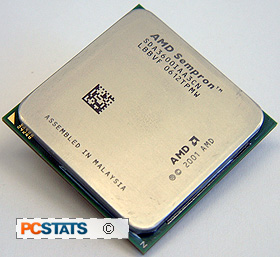Since the AMD Sempron 3600+ processor shares the same
manufacturing process with its Socket AM2 Athlon64 cousins, it should
technically share all the same technologies as well. The Socket AM2 version of
the 2.0GHz Sempron processor supports X86-64 bit tech, non-executable bit (NX
Bit) and an integrated DDR2 memory controller. The only notable technology
that's absent from the Sempron 3600+ is AMD's 'Virtualization technology.' That
omission isn't much of an issue since Virtualization is a workstation feature
that is really not even that widely used at the moment. For the entry level
market it is really not required.
32/64 Bit
Technology:
 64-bit processors
have registers that hold 64-bit values, double that of 32-bit processors. This
translates to the ability to hold larger integers (numbers) in a single
register, making operations involving massive numbers considerably faster. It
also leads to more precision in floating point numbers, except that current
32-bit processors already support up to 80-bit floating-point values in a single
register. The major advantage of 64-bit computing is not in mathematical speed
though, but in the amount of memory that a 64-bit processor is able to address,
and consequentially use.
64-bit processors
have registers that hold 64-bit values, double that of 32-bit processors. This
translates to the ability to hold larger integers (numbers) in a single
register, making operations involving massive numbers considerably faster. It
also leads to more precision in floating point numbers, except that current
32-bit processors already support up to 80-bit floating-point values in a single
register. The major advantage of 64-bit computing is not in mathematical speed
though, but in the amount of memory that a 64-bit processor is able to address,
and consequentially use.
Memory addresses are run through the processor just like
any other value, meaning they are stored in the registers. The largest integer
number a 32-bit register can hold is around -2.1 to +2.1 billion. This
translates to a maximum of 4GB of physical memory.
Various work-arounds have been invented
for the server market to transcend this limitation, but all sacrifice
performance. 64-bit registers can effectively address up to 16 terabytes of
physical memory which, to paraphrase Bill Gates, ought
to be enough for anybody.
It should be noted at this point that 64-bit computing
is specific to the operation of the processor and the software that is feeding
it, not the other computer hardware in a system. There are no special '64-bit'
computer memory chips or other peripherals. The AMD Athlon 64 processor uses the
same PC hardware as conventional 32-bit systems.
Viruses, take
that!
The
second newish feature is support for the non-executable bit (or NX Bit), a form
of system security which attempts to end the possibility of buffer overflow
attacks - where malicious software overloads an area of memory then uses the
resulting memory hole to execute alien programs. It does this by restricting
which areas of memory can execute application code. The NX Bit feature must be
supported by both the operating system and the processor.
Microsoft
Windows XP Service Pack 2 includes support for it, and we saw this technology in
action first hand when it interrupted our running of the Business Winstone 2004
test.
Apparently the benchmark attempts to run active X controls
within an Internet Explorer Window as part of the test, and the system flagged
and halted this process. We've never had any problem with this technology using
Athlon 64 processors which also support it, but it's good to know the feature is
working.
AMD's DDR-2 Memory
Controller:
All
socket AM2 processors incorporate a DDR-2 memory controller, with an effective
dual channel memory bandwidth of up to 12.8 GB/sec when running dual channel
with DDR2-800 memory.
A single
hypertransport link of up to 8GB/sec between the CPU and motherboard core logic
is supported, so the total CPU bandwidth rounds out to as much as 20.8 GB/s. The
Athlon64 FX and X2 series of AM2 processors will support unbuffered DDR-2 667
& 800 memory (PC2-5300 and PC2-6400 respectively), whereas Athlon64 and
Sempron AM2 chips will operate with more affordable DDR-2 667 RAM. The Sempron
3600+ has no difficulty running its memory controller with DDR2-800 RAM, in case
you were wondering.
With the
dual channel DDR2-667 (PC2-5300) installed, the memory subsystem will provide up
to 10.6GB/s worth of bandwidth at any given time, almost double the bandwidth
than the single core Sempron 3600+ actually needs. The Athlon64/Sempron
architecture uses a memory controller embedded onto the CPU core, so it also
operates at the CPU clock speed. In other words, there is no delay in moving
data from the processor to the memory controller. Thus the memory controller on
the Sempron 3600+ runs at a full 2.0 GHz
While the
added bandwidth that DDR-2 RAM provides is certainly not going to hinder things,
the 2.0GHz Sempron 3600+ processor still as a very big sweet tooth for higher
quality lower latency DDR-2 RAM. In fact, memory latency has more of an impact
on the socket AM2 processor than memory bandwidth does... as you'll shortly see.
First though, let's have a closer look at the socket AM2 heatsink retention
frame and what it means to high end heatsinks all over the world. If this is old
news to you, jump ahead to the overclocking section below.
